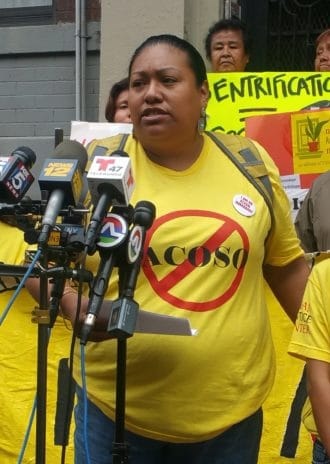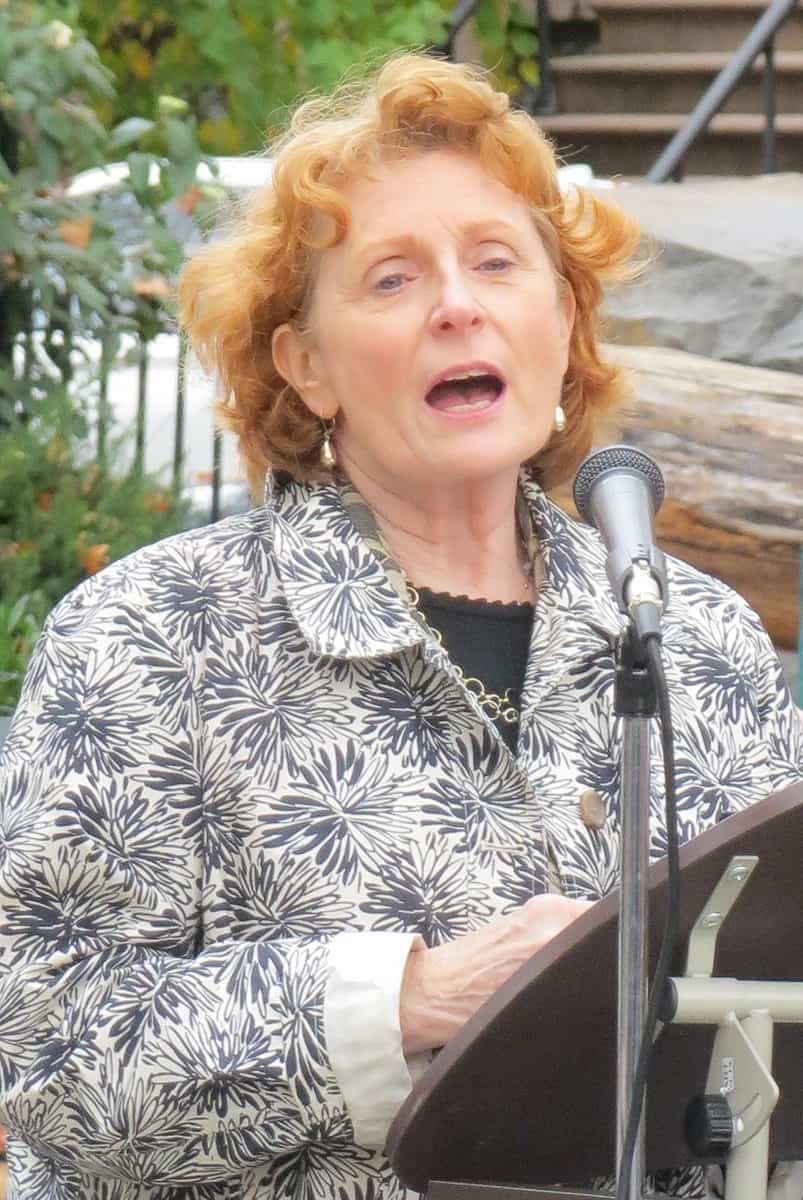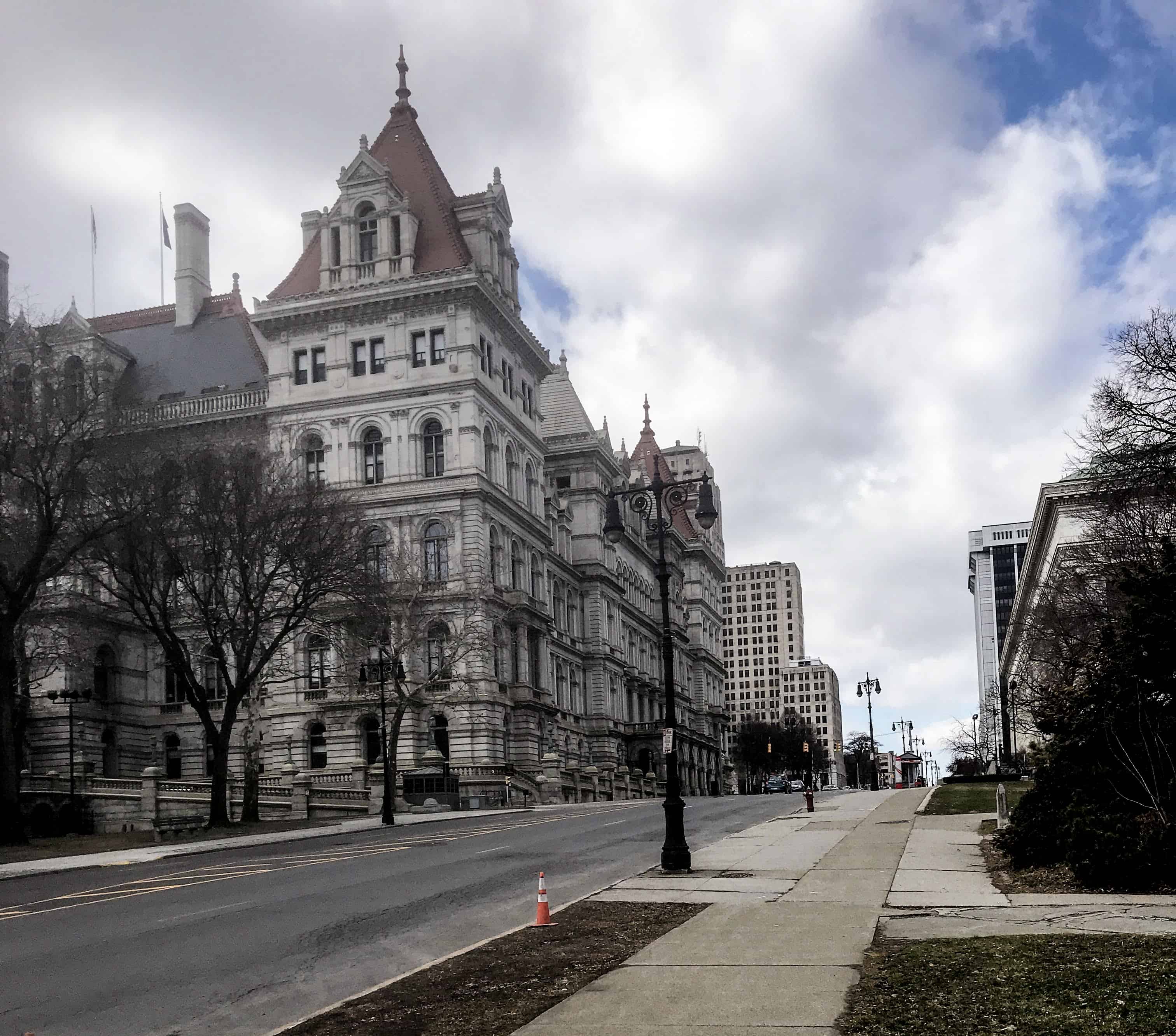The tenants won, and the real estate lobby lost. But the tenants didn’t win everything.

Signed into law on June 14 amid widespread celebration, the Housing Stability and Tenant Protection Act of 2019 (HSTPA) expanded and strengthened New York’s system of rent stabilization and offered a host of new benefits to tenants across the state. It suffered, however, from the absence of key provisions proposed by freshman State Senator Julia Salazar’s Good Cause Eviction bill that would’ve kept more renters in their homes.
The mere possibility of Good Cause Eviction – an anti-displacement measure unprecedented in New York State and a rebuke to price-gouging landlords – owed to the tenant unions and activist groups that formed the Upstate Downstate Housing Alliance in 2017. The 2018 election, which – thanks in part to progressive candidates boosted by housing activists – gave the Democrats full control of the State Legislature, brought significant momentum to the Alliance’s Housing Justice for All campaign. With New York’s rent laws nearing expiration, countless rallies, letters, phone calls, tweets, and sit-ins generated awareness and put pressure on lawmakers. During a June 4 demonstration, Albany police arrested 61 protesters.
Housing Justice for All promoted a suite of nine Democrat-sponsored bills under the banner of “Universal Rent Control.” Ultimately, eight of them made it – in some form – into the final package of rent reforms passed in June. The one that didn’t was Good Cause Eviction.
What Good Cause does
Like all Upstate renters, New York City renters who live in buildings constructed after 1973 or with fewer than six units don’t enjoy the advantages of rent stabilization, which include the right to a lease renewal. The Good Cause Eviction bill sought to extend protections to most of these tenants. As the law stands, when their leases expire (or if they don’t have a lease), their landlords can quickly and easily obtain a court order to kick them out. The court doesn’t ask for a reason.
With some exceptions, Good Cause Eviction would have guaranteed lease renewals even to tenants outside of rent stabilization – or, if a landlord wanted to evict them instead, they would have had to establish “good cause,” such as nuisance behavior by the tenant or the need to recover the unit for personal use by the landlord. But if they simply wanted to flip middle-income housing into luxury rentals, they’d have to wait until tenants moved out willingly. Nonpayment of rent would have been another acceptable reason for eviction – but, crucially, not if the nonpayment was the result of an “unconscionable” rent increase.
According to the text of the bill, “it shall be a rebuttable presumption that the rent for a dwelling not protected by rent regulation is unconscionable if said rent has been increased in any calendar year by a percentage exceeding one and one-half times the annual percentage change in the Consumer Price Index for the region in which the housing accommodation is located.”
In other words, Good Cause Eviction wouldn’t technically have prohibited landlords from putting major rent hikes into their lease renewals, but supporters of the bill believed that it would have made such hikes far less common by safeguarding tenants unable or unwilling to pay them. It would have given them a chance to argue for fairer, more affordable terms. (The word “rebuttable” still left some room for judges to authorize large increases if the landlord could, perhaps, cite a rise in property taxes or an expensive roof repair.)
Prior to 2019, the Democrat-controlled New York State Assembly had passed various rent reforms that had subsequently withered in the Republican-controlled Senate. Legislators had already seen versions of nearly all the bills supported by Housing Justice for All. But until the democratic socialist Salazar unseated longtime incumbent Martin Malave Dilan in Bushwick, no such bill as Good Cause Eviction had entered the legislature.
Property owners resist
“There was a lot, a lot of controversy around that bill,” acknowledged Shakti-Robbins Cubas, community liaison for State Senator Velmanette Montgomery, who represents Red Hook. Montgomery cosponsored Good Cause Eviction, which Pamela J. Hunter of Syracuse introduced in the Assembly.
Balanda Joachim works at the Carroll Gardens Association (CGA) on behalf of the Southwest Brooklyn Tenant Union, which fought for Universal Rent Control. “With Good Cause, what I believe is that it really questioned people’s sense of morality. Hence the name ‘good cause’: having landlords need a really good reason to evict you,” she said.
Statewide Housing Organizer Rebecca Garrard of Citizen Action of NY explained further: “There was this very emotional reaction to the idea of being unable to retain property rights. At a conference this weekend, I ran into a self-described small landlord – she has over 700 tenants – and she felt very passionately that she should be able to sever the tenant-landlord relationship on a whim if it just didn’t feel right. Where we were able to fight back against the real estate industry’s messaging on all our other bills, it was this emotional piece that we just kind of ran out of road in moving beyond.”
To Garrard’s surprise, Salazar’s bill’s eviction protections, rather than its soft cap on rent increases, had turned out to be the sticking point. Although many of its detractors appeared to regard Good Cause Eviction as a Marxist takeover of the housing business, she stressed the moderate nature of the proposed legislation.
“We really do believe it’s a baseline bill in that it provides a ton of leeway for a property owner to evict a tenant. All it does is force a property owner to prove that there is a reason to evict a tenant,” she asserted. “That’s really all it does. And it also attaches a rent increase limit that still allows for profitability while allowing carveouts to recoup your money for any investment made above and beyond that profitability. Is it a cap on profitability? Sure, but it’s an inherent profitability, and it’s not tied to the structure – it’s tied to the tenant, so if the tenant moves out, you can reset the rent to whatever you want.”
Michael Carter, Salazar’s director of communications, pointed to a recent overseas precedent: “Actually, the entire UK passed a version of Good Cause Eviction under its current Tory government this year, intended to deal with their housing crisis, so the concept of not allowing landlords to evict for no good reason is starting to become more common.” In April, a statewide poll showed that 68.1 percent of New Yorkers supported Good Cause Eviction, and only 17.4 percent opposed it.
Even so, the perceived radicalism of Good Cause Eviction in New York may have improved the chances of the other housing bills. “One of the things that the Good Cause bill was able to do was just move the terms of the conversation,” Carter observed. “At the beginning of the session, people were saying, ‘Oh, we’ll get rid of vacancy decontrol, and that’ll be the most radical thing we can do.’ But what started to happen is, basically, we were able to advocate for this policy that does have research behind it, has other locations that utilize it, and there really isn’t a good straightforward policy reason not to support Good Cause, so it put us in a position of being on the offensive instead of the defensive. The lobby was able to kill Good Cause, but because Good Cause was on the agenda, we were able to get so much into the final bill.”
The final bill – the HSTPA – passed largely along party lines. Four Democrats from Long Island (John Brooks, James Gaughran, Anna Kaplan, and Monica R. Martinez) voted against it in the Senate. Six Democrats in the Assembly (David Buchwald, Simcha Eichenstein, Sandy Galef, Amy Paulin, Steve Stern, and Carrie Woerner) did the same. Half of them came from Westchester County; Brooklyn’s Eichenstein represents Borough Park. Three other Assembly Democrats didn’t vote at all, marked by an ER (“excused with reason”) on the official tally.
The floor vote, however, did not reflect the full extent of the opposition to housing legislation within certain parts of the Democratic Party. Some of the lawmakers who approved the final package had worked to weaken its protections. The HSTPA was an omnibus; its constituent parts – the individual bills – never received public votes, and the process by which legislators excluded Good Cause Eviction took place behind closed doors.
In Carter’s recollection, it was a close call for Salazar and her allies in the legislature: “We were pushing Good Cause until four or five days before the session ended, so right up until the end it was still alive.”
Heastie scuttles Good Cause
The roadblock was the Assembly. In April, Speaker Carl Heastie, a Democrat from the Bronx, announced the lower chamber’s housing agenda for the legislative session; it consisted of all the Housing Justice for All bills except Good Cause Eviction, but he left open the possibility that the Assembly could incorporate at least some of its “elements” later on.
Just six days after NY1 reported that the Senate wouldn’t be able to muster enough votes to pass more than three of the bills, Majority Leader Andrea Stewart-Cousins, a Yonkers Democrat, announced on June 4 that the Senate had secured support for all nine. Four days before that, Heastie had stood beside her in a joint promise to pass “the strongest rent package ever.”
Throughout the legislative session, activists had pressed both the Assembly and the Senate to leave New York’s business-friendly governor out of the rent negotiations. But on June 5, the Upstate Downstate Housing Alliance alleged that Heastie had secretly consulted with Andrew Cuomo on ways to water down the proposed tenant protections.
Many of the Assembly Members had doubts about Good Cause Eviction, but in the view of Housing Justice for All Campaign Coordinator Cea Weaver, Heastie was the crucial factor. “If he liked the policy, I don’t think that their opposition was so strong that it wouldn’t have made it through.”

“In the past, it was easy for the Assembly to support things because they knew a lot of the stuff would just die in the Senate. So they had an opportunity to look good without having to do much,” commented Marcela Mitaynes, a Sunset Park resident who works for the nonprofit Neighbors Helping Neighbors. According to The Real Deal, the Real Estate Board of New York (REBNY) donated $153,000 to Assembly Democrats in 2018 and the first half of 2019, with another $367,000 coming from individual landlords and developers.
The activist Garrard put the bulk of the blame on Upstate Assembly Members for the loss of Good Cause Eviction. Outside of New York City, housing was a newer issue both for legislators and for political organizers. Meanwhile, Downstate activists had been working on the problem for years and had already managed to elect a number of officials who had sworn to eschew real estate dollars.
“Every single Assembly Member from Buffalo was a problem,” Garrard recalled. She also characterized Albany’s Patricia Fahy and John T. McDonald as “virulently anti-housing-legislation.” Weaver fingered Didi Barrett from Dutchess and Columbia counties and William B. Magnarelli from Syracuse as major obstacles.
Assembly Member Jo Anne Simon, who represents Carroll Gardens and multi-sponsored Good Cause Eviction, hinted at the same dynamic but showed more sympathy than Garrard: “For a lot of the state, this is the first time that they would’ve had any regulation at all, so that was kind of scary. And there are parts of the state where they don’t have a housing shortage. The world of New York City and the landlord-tenant relationship is fundamentally different from other parts of the state.”

Carter, Salazar’s staffer, spread the blame more evenly across the state: “I think the opposition was not limited to one area. On the one hand, Upstate folks have a tendency to be more conservative, but on the other hand, New York City folks have a tendency to be connected with the real estate industry.”
City legislators who voted no
According to insiders, at least eight Assembly Members from New York City, besides Heastie and Eichenstein, opposed Good Cause Eviction, though they may not have said so openly: Erik Dilan (Bushwick), Vivian Cook (Jamaica Estates), Michael Benedetto (Co-op City), Helene E. Weinstein (Sheepshead Bay), Peter J. Abbate Jr. (Bensonhurst), Michael G. DenDekker (Jackson Heights), Inez E. Dickens (Harlem), and Tremaine Wright (Bedford-Stuyvesant).
All eight have accepted donations from the real estate industry. “Tremaine Wright just didn’t support any of the bills,” noted Joachim of the CGA.
“I remember a specific conversation where I was at the table with Tremaine Wright,” fellow organizer Mitaynes recounted. “While she made it very clear that she wasn’t interested in the Good Cause bill, she was interested in trying to see if there’s a way that landlords can evict tenants faster. And just the idea of that was so insulting.”
Mitaynes had brought renters affected by New York City’s housing crisis to Albany to lobby for reforms. She knew that “it really was the tenants and their stories that were going to allow for these changes. The experiences that they shared as to the way that they were suffering were going to change the mind of a politician into wanting to vote in favor of this.”
Back home in Brooklyn, she struggled to help them with their problems, which she believed Good Cause Eviction would mitigate. “They’re suddenly being told that they have to vacate after they’ve been living there 10, 15, or 20 years,” she described. “All we could do was provide information as to what the process was going to be like. Tenants would come in, and I would have to tell them, ‘Yeah, this is a 30-day notice. Your landlord’s getting ready to sue you, and there’s nothing you can do to fight this. The only thing you can do is go to court and ask for time to move. Eventually, you are going to be evicted.’ That’s really heartbreaking.”
Mitaynes explained that, in Sunset Park, kicking out low-income tenants is often built into a landlord’s business plan when they buy a new property. “Excess greed is what happened here,” she opined.
In South Brooklyn, Joachim remarked upon the prevalence of small apartment buildings, which don’t fall under rent stabilization. Salazar’s bill would have covered four- and five-unit buildings. “Good Cause, especially in this area and in Red Hook, it would’ve been really good, even just for a start,” she concluded.
Meanwhile, Laura Felts, a court advocate at United Tenants of Albany, repudiated the notion that Good Cause Eviction was unnecessary outside of New York City: “In the city of Albany, there’s thousands of no-cause evictions every single year in our little city court. It’s really tough here because we have seriously decaying housing stock in the city of Albany, so we need tenants to be secure and feel safe when they’re calling code enforcement and making complaints to their landlords. The way the retaliatory eviction law functions right now, it’s just not enough, and the Good Cause Eviction bill really would’ve given tenants that safety we want them to have.”
The future of Good Cause
Salazar has promised to take up the Good Cause Eviction bill again in the 2020 legislative session. “The movement continues,” Carter declared.
Simon, however, doubted its immediate prospects: “We just shifted dramatically the face of the earth on the landscape of housing in the state. My sense is that, coming back with aspects of the Good Cause Eviction bill too soon, when there’s no history or track record of how the current law is working, we won’t have any basis to know whether additional protections are needed. If in fact people are not experiencing housing stability, we’ll find that out, but we don’t know that yet. I think that the stomach for making additional changes will probably not be there right away.”
Garrard, on the other hand, vowed to keep fighting, and she likes her chances. The Upstate Downstate Housing Alliance has only gotten stronger; 66 organizations participated in its Housing Justice for All campaign.
“I expect that elected officials will hear from their constituents more consistently, more clearly, and I think the message will be more direct, especially with next year being a primary year going into an election year, that the narrative that was said to them last year – that housing is not an Upstate problem – is not one that will be tolerated in the next legislative session,” she warned. “Every single zip code in this state, if you walk into a community, can tell you that housing is a problem. So that line that was repeated over and over in newspaper article after newspaper article, on the floor of both chambers, that ‘this just isn’t a problem in my district’ is just simply not going to hold water anymore.”
Felts has hopes for even stronger protections. She supports the Good Cause Eviction bill but believes that it puts tenants in a “defensive posture” when faced with an eviction or an unconscionable rent increase.
“To be able to assert your right to not have to face that kind of a rent increase, you’d have to fail to pay it, be petitioned to court for nonpayment of rent, and then assert why you didn’t pay it,” she said. “But if you lose, then you’re homeless. So it feels more like there should be something proactive that stops that rent increase from happening at all, or that, once it happens, the tenant could bring a separate right of action to have that be looked at without there necessarily being a warrant of eviction on the table.”
On behalf of Salazar’s office, Carter affirmed that if the senator makes any changes to Good Cause Eviction next year, they’ll only make the bill stronger for tenants.
“This bill is important because we believe that housing is a human right, and right now in New York State and New York City, we are using our limited space and our limited land and our limited housing stock for building profits for people who don’t invest in our communities,” he stated. “With Good Cause, in combination with other measures like it and with the rent laws of 2019, we can start to bandage the wounds that were created by years of irresponsible speculation leading to gentrification.”









